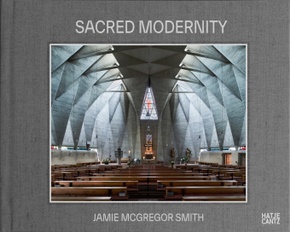Sacred Modernity - The Holy Embrace of Modernist Architecture. Zweisprachige Ausgabe
| Verlag | Hatje Cantz Verlag |
| Auflage | 2024 |
| Seiten | 208 |
| Format | 24,8 x 1,9 x 29,8 cm |
| Gewicht | 1576 g |
| ISBN-10 | 3775756469 |
| ISBN-13 | 9783775756464 |
| Bestell-Nr | 77575646A |
Rezension:
»Whatever the flavour of your religious persuasion, an impressive interior will have the power to inspire awe. That's certainly the case for these architectural wonders, some little known and rarely visited.« Jonathan Bell Wallpaper_ 20220902
- Europe's post-war sacred spaces- Still controversial, whilst revisited by contemporaryarchitects, designers and scholars- Over 50 awe-inspiring modernist churches in Austria,Italy, Switzerland, and England
- Europe's post-war sacred spaces- Still controversial, whilst revisited by contemporaryarchitects, designers and scholars- Over 50 awe-inspiring modernist churches in Austria,Italy, Switzerland, and England
Sacred Modernity documents the dramatic shift in ecclesiasticalarchitecture across post-war Europe. Spurred on bythe modernizing impulses of the Second Vatican Councilin the early 1960s, and in search for an appropriate architecturallanguage that showed that the Catholic Churchwas still relevant to the modern world, this was the periodwhen the church married the atheist architect, and bore achild of pure form. Among these structures, some exude ajoyful antagonism, while others emanate a cold minimalism.Boldly designed, outrageous and provocative for theirtime, the aesthetic of this period still ignites great debatebetween modernists and traditionalists.
Half a century on, this study traces how their materials andideals have matured and patinated. Remaining amongstthe most unique buildings within our public sphere, theyare future visions from the near past that seem to anticipatesocieties current shift away from organized religiontowards an individual spirituality.
The bo ok represents the first attempt by a photographer tocollate the religious architecture of the mid-century highmodern years that took many forms, from Brutalism toStructural Expressionism, under a singular artistic vision.
JAMIE McGREGOR SMITH (_1982, Weymouth, UK) studiedphotography at Staffordshire University, graduating in 2006.Inspired by the American New-Topographic movement, he beganhis documentary records with the defunct pottery industry in theBritish midlands, the collapse of the motor industry in Detroit, orthe abandoned Athens Olympics stadiums. His works have beenpublished by The New York Times, The Guardian, the FinancialTimes, Wallpaper_, Architectural Digest and Vanity Fair.

